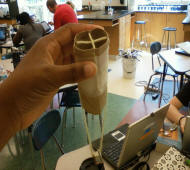PROCEDURE PROCEDURE PROCEDURE
1. Make a densiometer
Get an empty toilet paper roll
Take two pieces of string and separate the top of the toilet paper roll into four equal quadrants with the string
Tape the string to the sides of the toilet paper roll
Take another piece of string and slip a bolt onto it
Then tape the ends of the string onto the sides of the toilet paper roll so that the bolt is dangling below.

2. Look for areas that have different densities of vegetation with the densiometer
When less than 1 quarter of the densiometer is filled it is considered to have a 0-25% vegetation density, which is the lowest density. When less than 3 quarters are filled, then it is considered to have a 50-75% vegetation density (medium), etc.

3. Go out to a vegetated area that has the same types of plants in all of the area
* when choosing your area for taking a sample, make sure all the different densities are from an area with consistently the same plantlife *
4. Label the flags with the densities below, then look for those densities.
5. label 5 bags with date and number corresponding with plant density
A. 1-Highest Density (76-100%)
B.
2-Medium Density (51-75%)
C.
3-Medium-Less Density (26-50%)
D.
4-Least Density (1-25%)
6.
Mark spot with flag with the correct plant
density
7. Take a core sample that is 15 cm deep and 2 cm wide using an auger
8.
Place the soil sample in the bag with the
corresponding density measurement to the area where the sample was taken
9.
Repeat the process until each bag has been
filled with a sample from an appropriately dense vegetated area
10. Using a chemical testing kit, perform a general soil extraction and using the general soil extract, test for potassium. (for examples please *click here*)

11.Chart your information. * for examples please *click here*
12.
Repeat the process for 5 days, taking the samples from the area your
flags were on the first day